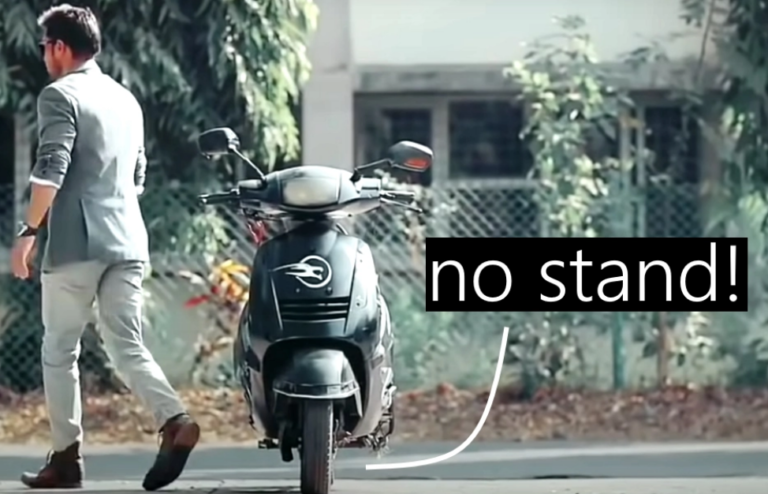Indian Startup Develops Country’s First Self Balancing Scooter

Indian Startup Develops Country’s First Self Balancing Scooter
Posted Date: February 11th, 2023
India is among the nations where two-wheelers are still the primary mode of transportation. The majority of road accidents, for a variety of reasons, also involve two-wheelers. Authorities have developed a number of laws and regulations over the years to help two-wheeler riders, yet accidents still happen. A team of IIT grads has now developed a solution for users of two-wheelers. This approach will alter the way that people see and use two-wheelers. They created the self-balancing scooter for India.
Before arriving at the version that appears in the film, the crew conducted research and created a number of prototypes. The scooter in the video also serves as a working prototype. While riding the scooter, the rider may effortlessly maintain both feet on the ground. The actual technologies that went into making this scooter are not disclosed in the video. Even if there isn’t anyone riding it, the scooter can maintain equilibrium. The ‘Feet Always’ onboard technology lowers the chance of a fall by assisting the user in always keeping their foot here on floorboard.
Affordable technology for two-wheeled mobility safety
With minimal financial impact on customers, Liger Mobility has already been trying to change the dynamics for two-wheelers both in terms of safety and enjoyment for their users. The self-balancing technology developed by the start-up, which will make two-wheelers safe and passengers more secure, will probably raise the price of the vehicle by around 10% or so. The two-wheeler is the main form of transportation in India, not just in small villages but also in big cities like Mumbai, Pune, and other metro areas, according to Upadhyay. The ease of mobility, cheap cost of ownership, and need for little maintenance make two-wheelers a preferred means of transportation. Many individuals desire to utilize them because of this, yet there are some of them feel uncomfortable with them as well.
Autonomous and self-balancing are only the beginning.
With the use of a modified scooter, Liger Mobility has created a functioning prototype that is self-balancing and self-parking, making it simple to operate for anybody, even those without bicycle riding expertise.
The co-founders were quick to say, “We are currently in the advanced phases of development,” when asked about the technology’s state of development. How far along we are in the finishing process is tough to measure. We can infer that a technologically sophisticated product exists and is in use. Currently, we are in an advanced prototype stage, and the finished product might be ready shortly.
Upadhyay states, “The entire concept Again, committing to a schedule at this point is probably not a good idea because it depends on many other circumstances, such as finance and the type of collaborative collaboration. Additionally, as it is a technology, it may constantly be evolving.
Any idea’s potential for realization hinges on how committed, persistent, and hardworking its originator is. For any successful organization, this means maintaining an edge over its competitors. The concept of self-balancing technologies and autonomous abilities within the two-wheeler arena is only the beginning for Liger Mobility. Eight people make up the core staff of the firm at the moment, including the two founders, engineers, fabricators, and machinists. The goal is to increase the team, bring in the appropriate personnel that can benefit the business’s objectives.
The focus on shared mobility
According to Poddar, “The Liger two-wheeler will eventually be more useful for the shared mobility industry for semi-autonomous or automated applications. We have very particular applications in mind for shared mobility. It is improper to focus just on the most recent jigsaw piece rather than the whole available narrative. Two-wheelers are important for all emerging nations, not just India. Two-wheelers are gradually becoming accepted in even developed markets. The overarching principle is if you can add value to two-wheelers.
The creator of Liger Mobility summarised the company’s mission as “Converting the Two-Wheeler Experience, & Bringing Intelligence to Two-Wheelers” in one short line.
Balancing technology independent of the powertrain
Although a few self-balancing 2 prototypes, notably an R1200 GS from BMW Motorrad, have been displayed by OEMs worldwide, launch services of such vehicles have not yet taken place. The expensive cost of this type of technology, which keeps the final product out of the reach of the majority, is one of the main causes of that.
Over 21 million IC-powered two-wheelers are sold annually in India. Could these petrol-powered robots use the self-balancing technology developed by Liger Mobility? “Our focus is not actually really short-term,” Upadhyay asserts. Our technology will work with either gasoline or electricity as a power source. Everywhere we can, we’ll aim to put it into practice so that more users may take use of it.
Since the answer is The system, which combines software and hardware, uses some power, but Liger Mobility claims it is aiming to make it energy-efficient to meet consumer concerns about two-wheeler use.
End Note
A self-balancing scooter made specifically for India by Liger Mobility reduces the risk of falling and offers cost-effective two-wheeled mobility safety technologies. Liger Transportation is creating autonomous capabilities and self-balancing technology for shared mobility. To address customer concerns regarding two-wheeler use, Liger Mobility is creating self-balancing technology that is independent of the powertrain.
Related Posts
Top Posts




Latest Post
Stay Informed
Sing up to stay update with Business, Lifestyle, Entertainment, and Many More.




